Navigation
World’s Largest Solar Hospital Provides Comprehensive Care in Haiti
The Hôpital Universitaire de Mirebalais, a solar-powered hospital situated on the Central Plateau of Haiti, shines as a beacon of hope in this country devastated by years of poverty and malnutrition, ravaged for decades by AIDS, demolished by an earthquake and suffering from cholera.
Video: Mirebalais Hospital Construction Complete
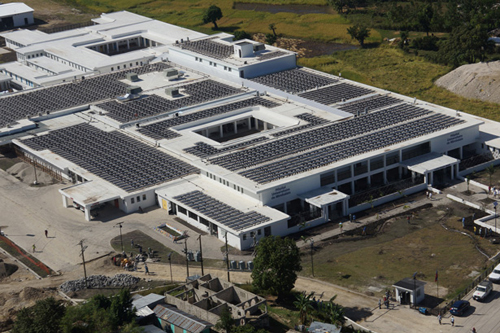
The Hôpital Universitaire de Mirebalais, a solar-powered hospital situated on the Central Plateau of Haiti, shines as a beacon of hope in this country devastated by years of poverty and malnutrition, ravaged for decades by AIDS, demolished by an earthquake and suffering from cholera.
The recently opened 205,000-square foot, state-of–the-art 300-bed Hôpital Universitaire de Mirebalais, (University Hospital) with more than 30 outpatient consulting rooms and six operating suites, is capable of serving 500 patients a day.
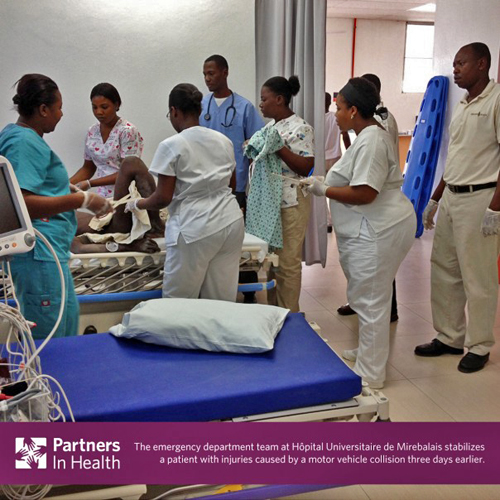 Inside the Emergency Room at University Hospital: MIREBALAIS, Haiti: In mid-June, University Hospital’s emergency department saw its first patient come through the door—a man in his 30s who was struck by a motor vehicle three days earlier. Dr. Jean Jimmy Plantin and Nurse Manager Heraldine Aneas led the team as they treated a complicated tibia/fibula fracture before admitting the patient to the surgical ward.
Inside the Emergency Room at University Hospital: MIREBALAIS, Haiti: In mid-June, University Hospital’s emergency department saw its first patient come through the door—a man in his 30s who was struck by a motor vehicle three days earlier. Dr. Jean Jimmy Plantin and Nurse Manager Heraldine Aneas led the team as they treated a complicated tibia/fibula fracture before admitting the patient to the surgical ward.
The hospital offers HIV/AIDS and TB care, treatment for noncommunicable diseases, prenatal care, primary care, and dental services, along with secondary level services that include mental health, emergency medicine, and general and orthopedic surgery.
“This hospital is the culmination of a dream dating back a quarter-century and underlines our commitment to the country and people of Haiti, which is stronger than ever after the earthquake,” said Dr. Paul Farmer, Co-founder, Partners In Health.
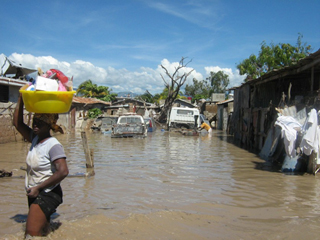 “We’re acutely aware that poverty, ill-health, and environmental degradation go hand-in-hand. Haiti's widespread deforestation,: and the devastating floods that have resulted, are an oft-cited example.” Text and photograph courtesy of Partners In HealthTheir thirty-year vision for University Hospital grew after the country’s 2010 earthquake, when the Haitian Ministry of Health asked Partners In Health (PIH) and its sister organization, Zanmi Lasante (ZL), to dramatically scale up existing plans for a small community hospital they were planning to build in Mirebalais.
“We’re acutely aware that poverty, ill-health, and environmental degradation go hand-in-hand. Haiti's widespread deforestation,: and the devastating floods that have resulted, are an oft-cited example.” Text and photograph courtesy of Partners In HealthTheir thirty-year vision for University Hospital grew after the country’s 2010 earthquake, when the Haitian Ministry of Health asked Partners In Health (PIH) and its sister organization, Zanmi Lasante (ZL), to dramatically scale up existing plans for a small community hospital they were planning to build in Mirebalais.
The University Hospital is “For me emblematic of our respect for the Haitian people and of our aspiration to make the fruits of science and the art of healing more readily available to people in sore need of them,” Dr. Farmer wrote in his recent book, To Repair the World.
Hundreds of people and organizations in Haiti, from the United States and around the world partnered with PIH to make this hospital a reality. “This state-of-the-art ‘green’ facility represents a significant investment in the quality of health services for the Haitian people,” said David Meltzer, chief international officer and general counsel for the American Red Cross, which contributed $5.5 million to help fund construction.
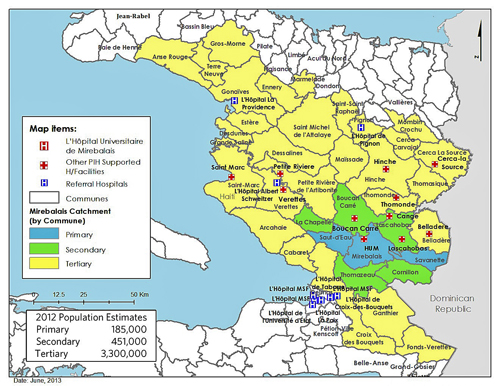 Catchment area for University Hospital. Map by Partners In Health MEQ team
Catchment area for University Hospital. Map by Partners In Health MEQ team
The hospital is providing primary care services to about 185,000 people in Mirebalais and two nearby communities and secondary and tertiary care to patients from a much wider area encompassing all of central Haiti and areas in and around Port-au-Prince. As many as 500 patients a day can be cared for in its ambulatory clinics.
State-of-the-Art Engineering for Health and Energy Efficiency
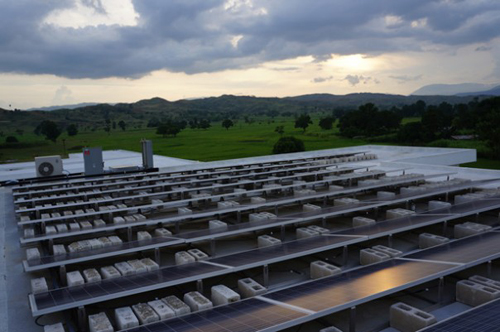 In order to maximize energy production, researchers from the University of Oregon provided sun charts: that showed how to best position the panels. Though Haiti’s ample sunshine is what powers the hospital, the scorching temperature of a sunbaked roof could actually cause the panels to produce less electricity. To work around this conundrum, engineers floated the panels about a foot above the roof and added a coat of white paint, which lowers the surface temperature and bounces more sunrays on to the panels. “This is an incredibly simple system to maintain...,” Ansara said. “All we need to do is rinse the panels quarterly with water.” Photograph courtesy of Partners In Health
In order to maximize energy production, researchers from the University of Oregon provided sun charts: that showed how to best position the panels. Though Haiti’s ample sunshine is what powers the hospital, the scorching temperature of a sunbaked roof could actually cause the panels to produce less electricity. To work around this conundrum, engineers floated the panels about a foot above the roof and added a coat of white paint, which lowers the surface temperature and bounces more sunrays on to the panels. “This is an incredibly simple system to maintain...,” Ansara said. “All we need to do is rinse the panels quarterly with water.” Photograph courtesy of Partners In Health
University Hospital is the largest solar-powered hospital in the world capable of producing more than 100 percent of its energy needs during peak daylight hours. Reflective white coating on the roof keeps the building cooler and makes the solar panels up to 15 percent more efficient. Any excess energy generated by the hospital’s 1,800 rooftop solar panels is fed back into the power grid, helping to strengthen the local infrastructure.
The hospital’s green technology design incorporates electricity conservation measures, natural ventilation and lighting, water-efficient plumbing, and a solar energy system that’s among the most ambitious health-sector solar projects ever undertaken in a developing country. In fact, according to publicly available data, University Hospital (HUM for short) is the largest hospital in the world powered entirely by solar energy.
Working with the Ministry of Health, PIH chose to use solar power as a cost-effective, reliable, and environmentally responsible way to help power the facility and avoid the burden of Haiti’s frequent blackouts. On most sunny days, the system’s solar panels can generate more electricity than the hospital consumes, allowing the surplus energy to feed back into the electrical utility.
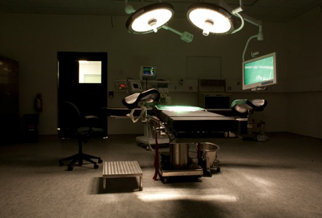
All this new technology was introduced with an eye toward sustainability: Professionally trained Haitian staff regularly service the equipment.
University Hospital is the first public hospital in Haiti to have a CT scanner. This portable CT scanner (manufactured by NeuroLogica) was originally developed for resource-poor settings. It is now also being used in U.S. hospitals.
“The wastewater treatment system at Mirebalais, the guts of the hospital, is truly remarkable. It takes the wastewater, the gray water as it’s called, and runs it through a pretty sophisticated but easy-to-maintain system that gets checked every day,” Farmer said. “We never had that in Haiti—not just in a hospital, we never had it at any public-sector institution. It’s hard to know why these things are so significant without knowing how absent they are in a lot of places in the world. This system is just one example of how a modern hospital runs that’s worth getting to know.”
Ann Polaneczky, PIH’s project engineer, describes the wastewater treatment system and other features University Hospital engineered systems she was instrumental in bringing about in the following edited excerpts. Her full text is available at: Five Feats of Engineering at University Hospital.
The wastewater treatment system
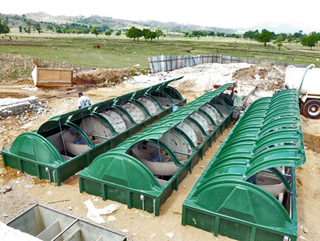 Wastewater Treatment System: Photograph by Partners In HealthEvery drop of wastewater produced at University Hospital—whether from a toilet, an operating room sink, or dirty laundry—passes through this low-energy, low-maintenance system.
Wastewater Treatment System: Photograph by Partners In HealthEvery drop of wastewater produced at University Hospital—whether from a toilet, an operating room sink, or dirty laundry—passes through this low-energy, low-maintenance system.
The water first enters a biological treatment process known as aerobic digestion in which naturally grown bacteria decompose organic waste and devour pathogenic organisms, such as Vibrio cholerae—the bacterium that causes cholera. From there, the water is treated with chlorine for further disinfection. Right now, the system can treat 50,000 gallons of wastewater per day to U.S. EPA standards. If needed, it can be expanded to treat 75,000 gallons a day.
The immediate benefit is that the wastewater treatment system significantly reduces the threat of waterborne diseases, such as cholera and dysentery.
We wanted to show that it’s possible to treat wastewater in an efficient, economical, and sustainable way in Haiti and other low-resource countries.
Incinerator
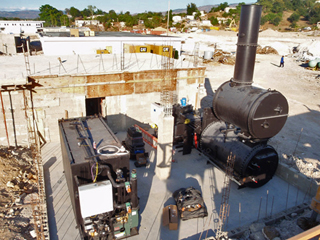 Incinerator: Photograph courtesy of Partners In Health
Incinerator: Photograph courtesy of Partners In Health
The large capacity incinerator allows University Hospital staff to properly dispose of biohazardous medical waste and used sharp instruments, including syringes and scalpels. The system meets U.S. EPA emission standards. The waste is burnt in a controlled fire in the machine’s first chamber. The resulting smoke is captured in a second chamber that reaches 1,000 degrees Celsius and, basically, gets vaporized. The end result is steam and a small pile of ash.
Properly disposing medical waste is critically important, yet many health care facilities in Haiti don’t have the necessary equipment to do so. It’s not uncommon for human waste to be mixed with sharp instruments and garbage, and then burnt in crude devices or trash pits. The noxious fumes are harmful to human health and the environment.
As University Hospital integrates further into Haiti’s health system, the incinerator may serve as a central location to dispose of medical waste produced at other PIH/ZL sites.
Fiber Optic Network
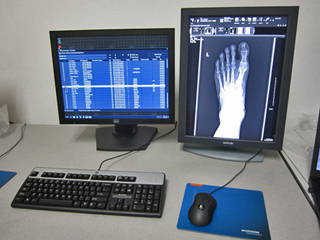 Fiber Optic Network: Photograph by Stephanie Garry/Partners In Health
Fiber Optic Network: Photograph by Stephanie Garry/Partners In Health
The fiber optic network provides high-speed Internet access throughout the facility. A robust server package (manufactured by HP) optimizes it. High-tech and resilient, University Hospital’s IT system supports everything from patient registration and inventory management to digital radiography. On a day-to-day basis, the network improves efficiency and facilitates monitoring, evaluation, and quality improvement projects.
Haitian doctors will be able to consult with partners in Boston and other medical centers through video conferencing and other digital technology directly from the hospital’s operating rooms and classrooms.
Medical Gas System
 Medical Gas System: Photograph by Rebecca E. Rollins/Partners In Health
Medical Gas System: Photograph by Rebecca E. Rollins/Partners In Health
Another major asset of University Hospital is its oxygen concentrator, a device that removes nitrogen from the air to produce medical-grade oxygen. A labyrinth of copper pipes and vacuum and air lines (hidden behind walls) ensure patients in need of oxygen have quick access to it whether they’re undergoing surgery, being cared for in the emergency room, or in recovery.
This system takes the place of expensive and logistically difficult tanks.
HVAC

The hospital has four 12.5-ton rooftop cooling units to provide air conditioning and a separate 20-ton condenser to protect temperature-sensitive medicines in the pharmacy.
The HVAC (heating, ventilation, and air conditioning) system supports infection control in operating rooms and helps preserve medical equipment. University Hospital’s HVAC system utilizes HEPA (High-efficiency particulate air, a type of air filter) filtration and laminar flow, meaning the air is pushed from ceiling to floor rather than across a room, which minimizes the risk of surgical infections.
Energy-efficient ceiling fans and airflow provide for natural temperature control to augment the air-conditioned areas.
Training for doctors, nurses, and other healthcare professionals
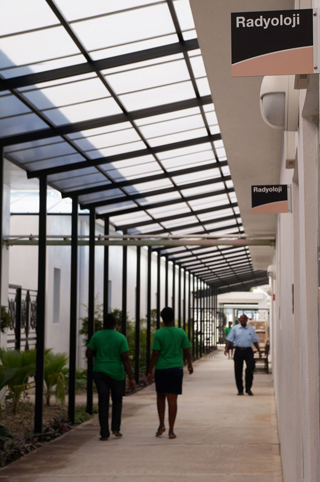 Inviting corridor at University Hospital: Photograph courtesy of Partners In Health"We recognize that there is an immediate need to repair the pipeline of medical professionals in Haiti, and this hospital addresses the crucial demand for state-of-the-art in-country training," said Meltzer.
Inviting corridor at University Hospital: Photograph courtesy of Partners In Health"We recognize that there is an immediate need to repair the pipeline of medical professionals in Haiti, and this hospital addresses the crucial demand for state-of-the-art in-country training," said Meltzer.
In addition to making high-quality medical care accessible to Haitians the University Hospital will continue strengthening Haiti’s public health infrastructure through medical education for doctors, nurses, and other healthcare professionals.
Several classrooms on the hospital’s second floor are equipped with high-speed Internet and video-conferencing capabilities (described above) that will enable Haitian nursing and medical students to participate in lectures at U.S. medical schools.
PIH/Zanmi Lasante are working with l’Université d’Etat d’HaÏti, l’Ecole Nationale des Infirmières [the national medical and nursing schools, respectively], and other international partners to develop academic programs to train future generations of nurses, doctors, and other health professionals to “strengthen the next generation of health providers.”
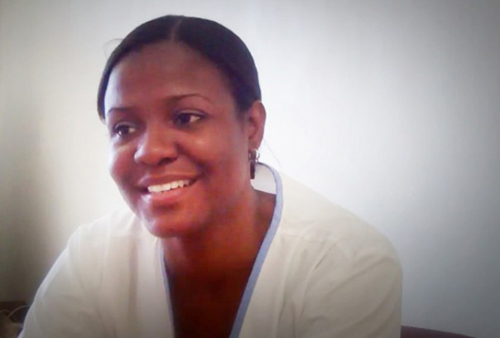 Alexandra Millien, nurse manager at University Hospital's outpatient clinic in Mirebalais, Haiti.: "This is a large hospital with a lot of new equipment that we’ve never had access to before. It’s a really incredible opportunity to provide the highest standard of nursing possible….Every month there’s an evaluation of nurses…Every person at every stage of care is doing everything they can that is best for their patient." Asked "What would you ask the global nursing community?" Millien replied, "I’d ask the international nursing community to help Haitian nurses stay up-to-date on all new advancements…We’d like training opportunities for Haitian nurses to happen in a timely fashion so they’re not behind the times." Photograph by Sheila Davis / Partners In Health
Alexandra Millien, nurse manager at University Hospital's outpatient clinic in Mirebalais, Haiti.: "This is a large hospital with a lot of new equipment that we’ve never had access to before. It’s a really incredible opportunity to provide the highest standard of nursing possible….Every month there’s an evaluation of nurses…Every person at every stage of care is doing everything they can that is best for their patient." Asked "What would you ask the global nursing community?" Millien replied, "I’d ask the international nursing community to help Haitian nurses stay up-to-date on all new advancements…We’d like training opportunities for Haitian nurses to happen in a timely fashion so they’re not behind the times." Photograph by Sheila Davis / Partners In Health
“We want to help retain health professionals for the public sector here by creating an environment that offers the tools, resources, supervision, and mentoring and academic environment they need to be satisfied in their jobs and advance in their careers,” said Drs. Raymonville and Walton, physicians for PIH/Zanmi Lasante and members of the executive leadership team of Mirebalais National Teaching Hospital.
“To that end, PIH/ZL will offer medical residencies at HUM in several areas, including internal medicine, obstetrics and gynecology, and surgery.”
The hospital will serve as a site for clinical rotations for Haiti’s national nursing schools, and offer nurses advanced training in several specialty areas, including emergency care, neonatal intensive care, and surgery.
Local residents are benefitting from training and from employment. Partners In Health and Zanmi Lasante estimate that eventually more than 1,000 people, including 175 community health workers, drawn primarily from the Mirebalais area, will be employed by the hospital.
Providing Care Outside the Medical Facilities
In these and many other ways, Partners In Health care extends beyond the health facilities themselves.
Recognizing that being concerned with the whole health condition of a patient and being on hand for them personally as much as possible is crucial to good care, PIH incorporates several features that enable them to address their patient’s whole care as much as they can.
Accompaniment
A major feature of PIH’s approach to care is “accompaniment.” It is a concept applied in interaction with patients. It is at the heart of PIH’s health care approach in all of its work in each of the 12 countries they now serve. It involves being there for them so that they are not alone facing a health concern. It involves care coordination, walking with patients to a care centers, going to a patient’s home, talking with patients about their nutrition and medicine, seeing that patients get to where they need to be, and that they understand their health situation and are able to take their medicine. And, it involves bringing on and working with partners whether they are educators or lawyers that are needed to address a patient’s concerns. And, accompaniment involves enjoying the patient’s successful recovery with them.
http://www.pih.org/blog/video-defining-accompaniment-it-has-to-come-from-your-heart
Nutrition Program Overview: Sustainable Progress in Haiti
To truly treat someone living with HIV, tuberculosis, or any number of other diseases, it’s vital to address the root causes of those conditions. That’s why PIH/ZL supports dozens of schools, hundreds of farms, housing and water projects throughout the region, and a facility that produces Nourimanba, a peanut and vitamin supplement for treating malnourished children.
Malnutrition and lack of economic opportunity have plagued Haiti for many years.
Today, Partners In Health (PIH), Abbott and the Abbott Fund are combining their unique expertise and resources to create a sustainable approach to combating childhood malnutrition in rural Haiti, working together to build local capacity and create long-term, impactful change in the Central Plateau, the poorest region in Haiti.
Malnutrition is among Haiti’s most significant health threats. Nearly every child seen at PIH clinics suffers from some degree of malnutrition. Likewise, the lack of economic opportunity is pervasive. Together they create a vicious cycle.
Dr. Farmer writes in To Repair the World, “…one of the lessons we have learned since the early days is that it’s difficult, sometimes impossible, to treat patients who don’t get enough food to eat. As many as half of school-aged children in Haiti, and almost all of those we meet in clinics and hospitals, live with chronic ‘food insecurity,’ to use the jargon of the day. One remedy for acute malnutrition is known as ready-to-use therapeutic food –RUFT for short. Colleagues from Médecins Sans Frontières showed in Niger that miraculous and tasty peanut butter paste could save the lives of most children with moderate and acute malnutrition.
 Peanut butter “For years, we’ve used a similar recipe in Central Haiti to make what we call. (Manba is the Haitian word for peanut butter.) Instead of buying this paste from abroad, we made our own using mostly locally procured ingredients – an obvious choice in a predominantly agricultural country like Haiti. After starting in the pharmacy warehouse in Cange, we soon built a tiny facility. As in Niger, we found the miracle paste worked well…The reliable market for peanuts created by this endeavor also helped lessen the food insecurity of local farmers.
Peanut butter “For years, we’ve used a similar recipe in Central Haiti to make what we call. (Manba is the Haitian word for peanut butter.) Instead of buying this paste from abroad, we made our own using mostly locally procured ingredients – an obvious choice in a predominantly agricultural country like Haiti. After starting in the pharmacy warehouse in Cange, we soon built a tiny facility. As in Niger, we found the miracle paste worked well…The reliable market for peanuts created by this endeavor also helped lessen the food insecurity of local farmers.
 Nourimanba a fortified food product popular in Haiti which will be sold to support plant operations.: Photograph courtesy of Partners In Health
Nourimanba a fortified food product popular in Haiti which will be sold to support plant operations.: Photograph courtesy of Partners In Health
“We’re now [May 25, 2011] working on a larger-scale facility with improved food-processing capacity.”
“Partners In Health, Abbott and the Abbott Fund are helping to fight malnutrition and drive economic development – empowering Haitians to build a stronger, sustainable future.” Learn more about how the partnership is accomplishing its dual goals of treating malnutrition and providing economic opportunity in Haiti. PIH discusses the partnership, available at http://partnershipinhaiti.org and a PDF can be downloaded at read more.
 New nutrition production facility in Haiti’s Central Plateau: Photograph courtesy of Partners In HealthA newly constructed manufacturing facility will improve and expand access to a life-saving nutritional product for thousands of Haitian children each year, while creating market opportunities for farmers. A new social enterprise also will help stimulate the local economy and support facility operations in the years ahead.
The result: a new model to help rebuild a stronger Haiti.
New nutrition production facility in Haiti’s Central Plateau: Photograph courtesy of Partners In HealthA newly constructed manufacturing facility will improve and expand access to a life-saving nutritional product for thousands of Haitian children each year, while creating market opportunities for farmers. A new social enterprise also will help stimulate the local economy and support facility operations in the years ahead.
The result: a new model to help rebuild a stronger Haiti.
The hub of the $6.5 million effort is an 18,000-square-foot nutrition facility that will produce Nourimanba, a therapeutic food used to treat severe malnutrition in children. Nourimanba is distributed through PIH’s network of health facilities throughout rural Haiti, providing free, life-saving treatment to thousands of Haitian children.
In addition, excess production capacity at the facility will be used to produce a fortified peanut butter that can be sold in Haiti. Revenue from peanut butter sales will be reinvested in the facility to cover the costs of Nourimanba production, with the goal of creating a social enterprise that will be self-sustaining over the long term.
More than 50 Abbott experts in science, manufacturing, engineering, marketing and other technical knowledge areas oversaw the design and construction of the facility, developed and refined product formulations and created strategic operating plans. PIH’s expertise in health care and agriculture, and a deep understanding of Haitian communities, ensures the partnership meets local needs.
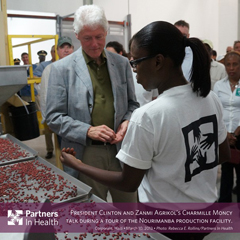 President Bill Clinton and a delegation of business representatives toured Partners In Health/Zanmi Lasante's Nourimanba: production facility in Corporant on March 10, 2013. President Clinton listens as Zanmi Agrikol quality control manager Charmille Moncy describes the peanut shelling process. Photograph by Rebecca E. Rollins / Partners In HealthExpanding economic opportunity is a key focus of the partnership. Through the facility, PIH will produce food products locally, providing an example of how to encourage local production to reduce Haiti’s reliance on imported foods. In addition, PIH and Abbott will hire local staff to manage operations and provide extensive training to transfer skills and build local capacity.
President Bill Clinton and a delegation of business representatives toured Partners In Health/Zanmi Lasante's Nourimanba: production facility in Corporant on March 10, 2013. President Clinton listens as Zanmi Agrikol quality control manager Charmille Moncy describes the peanut shelling process. Photograph by Rebecca E. Rollins / Partners In HealthExpanding economic opportunity is a key focus of the partnership. Through the facility, PIH will produce food products locally, providing an example of how to encourage local production to reduce Haiti’s reliance on imported foods. In addition, PIH and Abbott will hire local staff to manage operations and provide extensive training to transfer skills and build local capacity.
“Haiti needs self-sustaining institutions,” says Katherine Pickus, Divisional Vice President, Global Citizenship and Policy at Abbott. “We are focusing on creating a true local enterprise that is run by Haitians, for Haitians. The goal is to sustainably address malnutrition, while providing a model for driving economic opportunity.”
Growing a Vibrant Farming Sector
 An agricultural program will train approximately 400 farmers and create more than 40 jobs: Photograph courtesy of PIH
An agricultural program will train approximately 400 farmers and create more than 40 jobs: Photograph courtesy of PIH
With Haiti’s rich agricultural history and ideal growing conditions in the Central Plateau, there is tremendous opportunity to expand local peanut cultivation – which will provide a reliable supply of high-quality peanuts for the new facility.
Working together with PIH’s local partner organizations, Zanmi Lasante and Zanmi Agrikol, as well as leading agriculture consultants from TechnoServe, the partnership is supporting an agricultural pilot program to provide training and support for approximately 400 local smallholder farmers.
These farmers are acquiring new skills and expertise in farming practices, and receiving financing for seeds, fertilizer and other supplies. In addition, more than 40 local residents will be recruited and trained to provide services, such as tillage and harvest collection. In the first year, the effort is expected to improve crop quality, while increasing farmers’ incomes by as much as 400 percent.
The agricultural pilot program also will provide best practices that can be shared across Haiti in the coming years – with the goal of improving farming practices and boosting income for farmers across the country.
“Haiti is actually a very rich country in terms of natural resources,” says Stenio Louis-Jeune, a PIH agronomist. “The PIH-Abbott partnership is showing Haitians how to use those natural resources to create real change in their country.”
“An Innovative Approach to Longstanding Challenges,” a video introduction to a unique partnership between Partners In Health, Abbott, the Abbott Fund and local communities in Haiti is available at http://tmblr.co/ZwmMWtelsGXs.
Governance
ZL and PIH will operate the hospital under a Memorandum of Understanding with the Ministry of Health for several years. Eventually the Ministry of Health will manage the hospital. An accompaniment and mentorship approach has been used to pair Haitian leaders with international experts from the United States and elsewhere who have helped launch the hospital and are stewarding this transition. This is enabling HUM to demonstrate best practices in hospital management and to establish a strong Haitian leadership team that can make the hospital a success and a model for public hospitals throughout the country.
“HUM offers an incredible opportunity to raise the standard of health care for our patients in Haiti,” said Drs. Raymonville and Walton. “In partnership with the government, we have the capacity to provide high-quality services drawing on international best practices for healthcare delivery, administration, and education. We hope that our work will improve care both throughout our PIH/ZL network and across Haiti.”
The Major Supporters of University Hospital Included the Following:
GE Foundation provided training and medical equipment for maternity cases, trauma, and acute illnesses, as well as a cutting-edge teaching environment to train practitioners. “This hospital is proof that through public-private partnerships, we can provide sustainable, quality healthcare to a region that needs it most,” said Bob Corcoran, President and Chairman of the GE Foundation.
Funding from HP allowed PIH to outfit the hospital with a high-capacity server rack that provides connectivity across the campus via thin clients, wireless access points, and VoIP phones. Twelve HP workstations are situated throughout the hospital, equipped with 27-inch monitors to enable teaching opportunities in the operating rooms and optimum radiology image viewing. “The best medical advice from healthcare experts around the world will be available at the click of a mouse,” said Gabi Zedlmayer, HP Vice President, Sustainability and Social Innovation.
Artists for Haiti contributed essential start-up costs of $2.7 million. “Hôpital Universitaire de Mirebalais will not only provide world-class health care to the people of Haiti, but will contribute to the country’s sustainable future with significant employment opportunities,” said Ben Stiller, co-founder with David Zwirner of Artists for Haiti.
“Paul Farmer has been a huge source of inspiration behind Artists for Haiti, and we are excited to support Partners In Health in its continued efforts to bring quality health care to the country,” said Zwirner at the April 28, 2013 celebration of the hospital in Mirebalais, Haiti.
Article published on 8 July 2013. Partners In Health provided substantial text and images for this article for which Horizon International is grateful.
Notes:
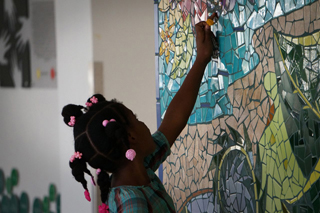 Girl with mural in University Hospital
Girl with mural in University Hospital
Partners In Health is a global health organization committed to improving the health of the poor and marginalized. PIH builds local capacity and works closely with impoverished communities to “deliver high-quality health care, address the root causes of illness, train providers, advance research and advocate for global policy change.” Ninety-three percent of the funds PIH raises go to its programs in the 12 countries where it works. These include Haiti, Rwanda, Russia, Peru and the United States.
Read more about Hôpital Universitaire de Mirebalais:
· Solar-Powered Hospital in Haiti Yields Sustainable Savings
· World Bank President Jim Yong Kim Celebrates Hospital Construction
· Mirebalais: Hospital Construction Complete
· Video: Mirebalais Hospital Construction Complete

“We believe that love and imagination are potent weapons
in the fight for the poor,” Ophelia Dahl, Executive Director and Co-founder PIH
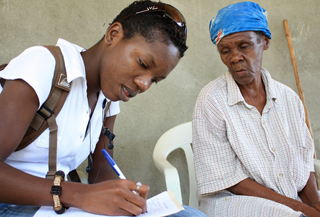
In fiscal year 2011, ZL provided:
• 2.8 million patient encounters
• 13,784 children with educational assistance
• 6,268 helped HIV-positive patients on treatment
• 98,735 pregnant women seen in antenatal clinics
• 53 houses constructed or repaired
• 482 tuberculosis patients treated
• 75,000 cholera patients treated
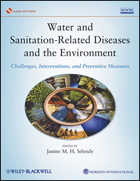 Book CoverThis article is presented as part of the Supplementary Material that accompanies the book Water and Sanitation Related Diseases and the Environment: Challenges, Interventions, and Preventive Measures, a Wiley-Blackwell publication in collaboration with Horizon International, written by 59 experts. Janine M. H. Selendy, Horizon International Founder, Chairman, President and Publisher, is Editor.
Book CoverThis article is presented as part of the Supplementary Material that accompanies the book Water and Sanitation Related Diseases and the Environment: Challenges, Interventions, and Preventive Measures, a Wiley-Blackwell publication in collaboration with Horizon International, written by 59 experts. Janine M. H. Selendy, Horizon International Founder, Chairman, President and Publisher, is Editor.
The book’s 4 hours of multimedia DVDs are included with an abundance of multidisciplinary resources, covering diverse topics from anthropology to economics to global health are being distributed free of charge by the Global Development And Environment Institute (GDAE) at Tufts University.
These will be sent to thousands of libraries, organizations, and institutions in 138 less-wealthy countries and will be invaluable additions to library materials for use in classrooms and communities, by researchers and government decision-makers.
 Map of countries
Map of countries
As of June 25, 2013, these resources have been made available in over 1,200 entities across 55 countries.
Read more: PDF Version is available at http://solutions-site.org/press/release1july2013.pdf
Search
Latest articles
Agriculture
- World Water Week: Healthy ecosystems essential to human health: from coronavirus to malnutrition Online session Wednesday 24 August 17:00-18:20
- World Water Week: Healthy ecosystems essential to human health: from coronavirus to malnutrition Online session Wednesday 24 August 17:00-18:20
Air Pollution
- "Water and Sanitation-Related Diseases and the Changing Environment: Challenges, Interventions, and Preventive Measures" Volume 2 Is Now Available
- Global Innovation Exchange Co-Created by Horizon International, USAID, Bill and Melinda Gates Foundation and Others
Biodiversity
- It is time for international mobilization against climate change
- World Water Week: Healthy ecosystems essential to human health: from coronavirus to malnutrition Online session Wednesday 24 August 17:00-18:20
Desertification
- World Water Week: Healthy ecosystems essential to human health: from coronavirus to malnutrition Online session Wednesday 24 August 17:00-18:20
- UN Food Systems Summit Receives Over 1,200 Ideas to Help Meet Sustainable Development Goals
Endangered Species
- Mangrove Action Project Collaborates to Restore and Preserve Mangrove Ecosystems
- Coral Research in Palau offers a “Glimmer of Hope”
Energy
- Global Innovation Exchange Co-Created by Horizon International, USAID, Bill and Melinda Gates Foundation and Others
- Wildlife Preservation in Southeast Nova Scotia
Exhibits
- Global Innovation Exchange Co-Created by Horizon International, USAID, Bill and Melinda Gates Foundation and Others
- Coral Reefs
Forests
- NASA Satellites Reveal Major Shifts in Global Freshwater Updated June 2020
- Global Innovation Exchange Co-Created by Horizon International, USAID, Bill and Melinda Gates Foundation and Others
Global Climate Change
- It is time for international mobilization against climate change
- It is time for international mobilization against climate change
Global Health
- World Water Week: Healthy ecosystems essential to human health: from coronavirus to malnutrition Online session Wednesday 24 August 17:00-18:20
- More than 400 schoolgirls, family and teachers rescued from Afghanistan by small coalition
Industry
- "Water and Sanitation-Related Diseases and the Changing Environment: Challenges, Interventions, and Preventive Measures" Volume 2 Is Now Available
- Global Innovation Exchange Co-Created by Horizon International, USAID, Bill and Melinda Gates Foundation and Others
Natural Disaster Relief
- STOP ATTACKS ON HEALTH CARE IN UKRAINE
- Global Innovation Exchange Co-Created by Horizon International, USAID, Bill and Melinda Gates Foundation and Others
News and Special Reports
- World Water Week: Healthy ecosystems essential to human health: from coronavirus to malnutrition Online session Wednesday 24 August 17:00-18:20
- STOP ATTACKS ON HEALTH CARE IN UKRAINE
Oceans, Coral Reefs
- World Water Week: Healthy ecosystems essential to human health: from coronavirus to malnutrition Online session Wednesday 24 August 17:00-18:20
- Mangrove Action Project Collaborates to Restore and Preserve Mangrove Ecosystems
Pollution
- Zakaria Ouedraogo of Burkina Faso Produces Film “Nzoue Fiyen: Water Not Drinkable”
- "Water and Sanitation-Related Diseases and the Changing Environment: Challenges, Interventions, and Preventive Measures" Volume 2 Is Now Available
Population
- "Water and Sanitation-Related Diseases and the Changing Environment: Challenges, Interventions, and Preventive Measures" Volume 2 Is Now Available
- "Water and Sanitation-Related Diseases and the Changing Environment: Challenges, Interventions, and Preventive Measures" Volume 2 Is Now Available
Public Health
- Honouring the visionary behind India’s sanitation revolution
- Honouring the visionary behind India’s sanitation revolution
Rivers
- World Water Week: Healthy ecosystems essential to human health: from coronavirus to malnutrition Online session Wednesday 24 August 17:00-18:20
- Mangrove Action Project Collaborates to Restore and Preserve Mangrove Ecosystems
Sanitation
- Honouring the visionary behind India’s sanitation revolution
- Honouring the visionary behind India’s sanitation revolution
Toxic Chemicals
- "Water and Sanitation-Related Diseases and the Changing Environment: Challenges, Interventions, and Preventive Measures" Volume 2 Is Now Available
- Actions to Prevent Polluted Drinking Water in the United States
Transportation
- "Water and Sanitation-Related Diseases and the Changing Environment: Challenges, Interventions, and Preventive Measures" Volume 2 Is Now Available
- Urbanization Provides Opportunities for Transition to a Green Economy, Says New Report
Waste Management
- Honouring the visionary behind India’s sanitation revolution
- Honouring the visionary behind India’s sanitation revolution
Water
- Honouring the visionary behind India’s sanitation revolution
- Honouring the visionary behind India’s sanitation revolution
Water and Sanitation
- Honouring the visionary behind India’s sanitation revolution
- Honouring the visionary behind India’s sanitation revolution

